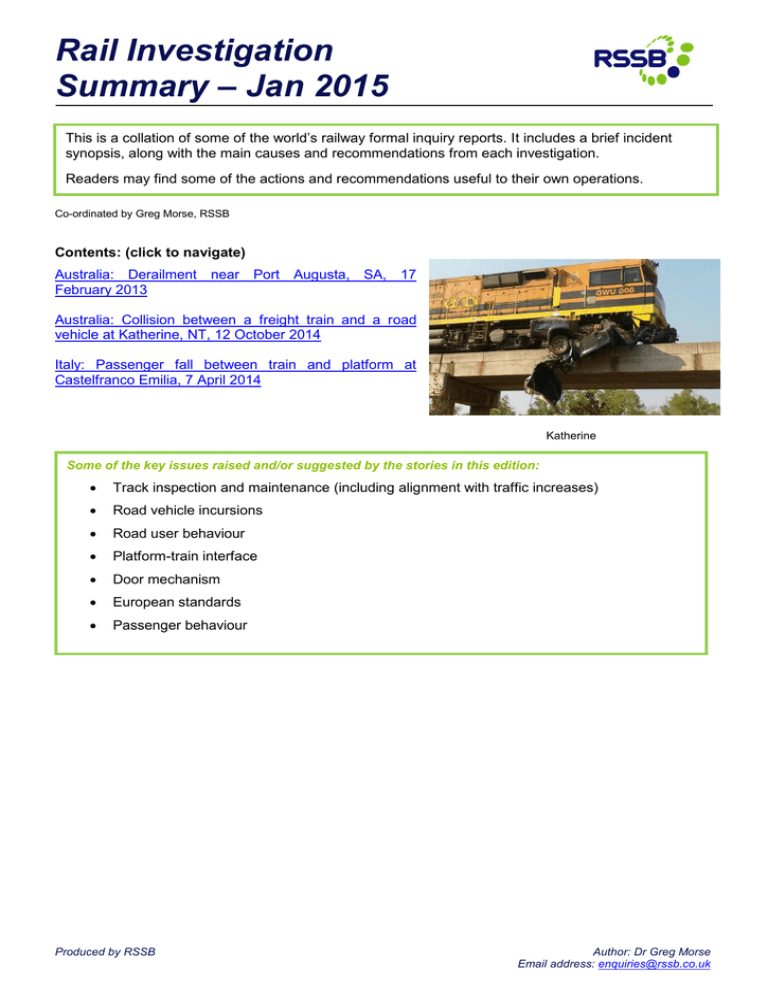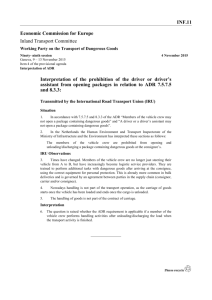Rail Investigation – Jan 2015 Summary
advertisement

Rail Investigation Summary – Jan 2015 This is a collation of some of the world’s railway formal inquiry reports. It includes a brief incident synopsis, along with the main causes and recommendations from each investigation. Readers may find some of the actions and recommendations useful to their own operations. Co-ordinated by Greg Morse, RSSB Contents: (click to navigate) Australia: Derailment near Port Augusta, SA, 17 February 2013 Australia: Collision between a freight train and a road vehicle at Katherine, NT, 12 October 2014 Italy: Passenger fall between train and platform at Castelfranco Emilia, 7 April 2014 Katherine Some of the key issues raised and/or suggested by the stories in this edition: Track inspection and maintenance (including alignment with traffic increases) Road vehicle incursions Road user behaviour Platform-train interface Door mechanism European standards Passenger behaviour Produced by RSSB Author: Dr Greg Morse Email address: enquiries@rssb.co.uk Rail Investigation Summary – Jan 2015 13 January Australia: Derailment near Port Augusta, SA, 17 February 2013 For the full report, clink here: LINK On 17 February 2013, an ore train was departing Spencer Junction en route to Whyalla, South Australia. While the train was traversing a set of points at the northern end of Spencer Junction, the driver noticed a change in its dynamic behaviour and immediately reduced the train speed. The train then quickly came to a stop due to the automatic application of the electronically controlled pneumatic train brake. Upon inspection of the train, the second driver found that five wagons had derailed. The Australian Transport Safety Bureau (ATSB) found that the leading edge of the right-hand point blade was worn and damaged. This had created a ramping angle, allowing the leading wheel of the wagon to ‘ride up’. The derailed wheels then impacted and damaged the concrete sleepers, which ultimately failed to maintain track gauge and allowed further wagons to come off. During the derailment sequence, a rupture to the train’s electronic control pneumatic pipe initiated the application of the train brake. The ATSB found that the Australian Rail Track Corporation’s inspection and maintenance regime, following two similar derailments at the same location, had not been sufficient to identify and remediate the deteriorating condition of the points, and ultimately contributed to the derailment. The ATSB added that track infrastructure owners and maintainers should consider the associated increase in wear on track infrastructure when there is an increase in the volume of rail vehicles being operated. The high dynamic forces that may be exerted from rail vehicles, specifically those that bear a heavy axle load, will accelerate the rate of wear on track infrastructure. In these circumstances, increased inspection and maintenance of track components should be considered until it can be established that resulting wear rates can be adequately managed in accordance with the established standards. Action taken In the months leading up to this derailment, Genesee Wyoming Australia (GWA) and the Australian Rail Track Corporation (ARTC) had agreed to a rail upgrade programme which included a new turnout incorporating 38A points, using 60 kg rail laid on concrete bearers. At the time of this derailment, a new turnout had been prepared, but had not yet been installed. Upgrade works have since been completed. Following installation of the upgraded infrastructure, more frequent monitoring for wear rates of the point blade(s) was undertaken. After several months of condition monitoring it became evident that track performance and wear rates could be managed as specified in the Code of Practice and the normal inspection schedule was reinstated. The ARTC acknowledged that the incident had identified several areas where safety outcomes could be enhanced: The need for remedial actions intended to return the asset to within the specified limits, (noting that the actions may consist of a number of tasks and application of a speed restriction) must be implemented in a timely manner and be both robust and sustainable. If necessary, increased targeted inspections to verify that the previously identified condition has been adequately addressed should be scheduled and the results documented. Strengthening of the existing internal interface between commercial, infrastructure and operational areas to ensure that initial consultation and ongoing dialogue on matters of mutual interest Produced by RSSB Author: Dr Greg Morse Email address: enquiries@rssb.co.uk Rail Investigation Summary – Jan 2015 The ATSB considers the safety issue ‘adequately addressed’. Recommendations None listed. Back to top 19 January Australia: Collision between a freight train and a road vehicle at Katherine, NT, 12 October 2014 For the full report, clink here: LINK At about 01:00 (local time) on 12 October 2014, a freight train passed through Katherine at 80 km/h. As it passed over Novis Quarry Road level crossing, the driver’s assistant noticed a car alongside the track. Soon after, the driver saw a white light being waved near the line further ahead and immediately applied the brake. About six seconds later, as the train rounded a bend, the driver saw a green utility road vehicle in the middle of the track immediately before the Katherine River Bridge. The driver made an emergency braken application and sounded the horn. At about 01:02, the leading locomotive struck the utility vehicle at around 70 km/h. The crew believed that the impact had derailed the locomotive and they were about to fall off the bridge and into the Katherine River. While the road vehicle became lodged under the leading bogie, the locomotive and the trailing wagons did not derail. The train travelled approximately 500 metres before finally coming to rest atop a culvert bridge, with the damaged vehicle hanging precariously over the right-hand side (see photo at top of document). The co-driver contacted Train Control and reported the collision while the driver went to the crew car to ensure the wellbeing of the other train crew before all three returned to the lead locomotive. One of the crew inspected the road vehicle and ascertained that no one was trapped inside. Northern Territory Police officers attended and provided assistance to all four crew members. Neither the driver of the vehicle nor any of the train crew was injured in the collision, although one member of train crew was taken to hospital as a precautionary measure. All crew members were relieved from duty. The driver of the road vehicle was interviewed by the Northern Territory Police. During the interview, he said that he had been trying to traverse the track just west of town when his car became stuck. Upon realising the approach of a train he had tried to warn the train by flashing a torch. The ATSB note that the point where the road vehicle attempted to traverse the line did not contain any structure that resembled a level crossing, or any other provisions for road vehicles to safely cross the track. Evidence showed that, in the attempt to cross, the road vehicle driver entered the rail corridor and mounted the east side of a steep embankment topped by the ballast formation supporting the track. The road vehicle’s front wheels subsequently ‘hung’ on the east rail, such that its chassis rested on the track ballast and embankment with the rear wheels only lightly contacting the ground and unable to provide sufficient tractive effort. There were a number of vehicle level crossings and road overpasses near Katherine, the closest being Novis Quarry Road, less than one kilometre from where the road vehicle attempted to traverse the track. While there is risk of injury or death to road vehicle occupants in the event of a collision with a train, there is also a very serious risk of injury or death to train crew and passengers in the likely event the train subsequently derails. At this location, say the ATSB, a derailment could have resulted in a train falling many metres into the Katherine River. Produced by RSSB Author: Dr Greg Morse Email address: enquiries@rssb.co.uk Rail Investigation Summary – Jan 2015 Safety message The ATSB says that this accident highlights the very significant risk of injury, death and serious damage that is associated with road vehicle operators attempting to cross railway lines in areas other than designated level crossings. Risks are not confined to the road vehicle and occupants – there is also a high likelihood of train derailment after any track collision, with significant associated risks to the train crew, passengers, freight and infrastructure. Recommendations None listed. Back to top 22 January Italy: Passenger fall between train and platform at Castelfranco Emilia, 7 April 2014 For the full report, click here: LINK (requires translation from Italian) At 21:53 (local time) on 7 April 2014, a passenger fell between a train and the platform at Castelfranco Emilia with fatal results. The passenger had forced the train doors and had tried to alight, but fell as the train began to move. The door then trapped his ankle, causing him to be dragged around 200 metres before his death. The investigation found that the on-board monitoring system did not stop the train when the doors were moved. The doors also appear to be non-compliant with the relevant European standard (EN 14752), as the doors do not lock when closed. The investigators also not that the train’s Driver Information System (DIS) had failed (although this was not causal to the event). Recommendations Trenitalia should change the design of its carriage doors such that they can be opened in an emergency, but not by passengers once the driver has initiated the closure sequence. Trenitalia should make sure it has checked that the DIS works correctly following train maintenance. Trenitalia should introduce a special procedure to deal with repeating maintenance issues. Back to top Produced by RSSB Author: Dr Greg Morse Email address: enquiries@rssb.co.uk




